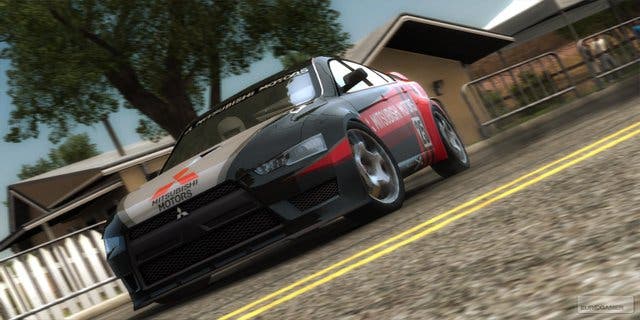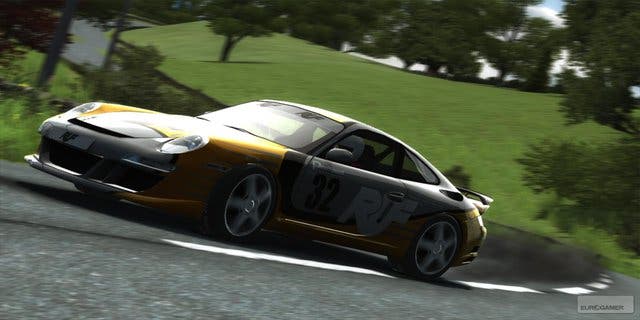SEGA Rally
Return of the arcade.
Arcade gaming: it's an evocative term loaded with promise and suggestion, yet one that's long since lost its cutting edge relevance and magnetism since its heyday. All too often it's lazily bandied around to sell new console games by people who seem to have forgotten what it actually means. SEGA hasn't.
Arcade games should be about providing the perfect quick fix to the passer-by; easy to learn, hard to master, pick-up-and-play goodness with a single line of explanation and a hungry coin-slot. Here's a great looking game....off you go. Enjoy.
That last paragraph neatly sums up why this modern reinvention of SEGA Rally works so well. It really is the perfect quick-fix driving experience that anyone can play; a fabulous looking game which requires zero explanation, with short, furiously intense three lap races that keep you coming back for more. Die hard, old school veterans will be astonished how well SEGA's new UK studio has nailed what was required, and newcomers will admire how fresh it all feels. A driving game that's not a complete slog to get into? A game which places fun front and centre from the moment you pick up the pad. Imagine that.
Easy like a Sunday morning

Reading between the lines, one of the main reasons SEGA Rally works from the off is that it's really easy and instinctive. Yes, easy. That's not a dirty word you just read: it's an absolute piece of piss to play - not because it lets you win (it doesn't), but because the handling's so bloody intuitive, and because you're not constantly being penalised for snagging your car on a pebble-sized obstacle on the side of the track. Inspired in no small part by Criterion's school of thought, crashing into the side of the course invariably bounces you back into play, and this crucial, fundamental piece of design keeps you moving forward, keeps you at high speed, keeps you in the race even when you're driving like a complete psycho.
Of course, purists have every right to whinge about this (purists always whinge about everything - damn you purists!), but SEGA Rally isn't a simulation: it's an arcade racing game which focuses on the furious charge of forward momentum, and how well you can read the ever-changing track conditions. As SEGA has been at pains to point out ever since it first demoed the game, dynamic track deformation is The Big Thing about its next generation reinvention of SEGA Rally; the premise being that as you churn up the course, it willl affect the handling conditons for when you return for the subsequent lap.
Although the tech demo certainly looked impressive, to a degree we couldn't help wonder whether it was a spurious PR claim as to how much it affects the driving. Happily, it's a roaring success. Whether you plough through the mud, churn up the snow, scatter the sand, or coarse through the loose shingle, your tracks are laid down - as are everyone else's. As you return on your second or third lap, you'll not only notice your own tracks (doubtlessly where you veered wildly off), but notice an appreciable handing difference, both in the amount of traction afforded to your car and the vibration transmitted through the pad. [And it's here where we'd ultimately recommend the 360 version over the PS3 - we cannot overstate how subliminally important it is to be able to feel the track in your hand. Relying on visual feedback alone simply won't be enough. You can play the game using the wheel on PS3 to get vibration, but it's not a game that really lends itself to steering wheel control.]

With such a responsive, drift-happy handling model, you can afford to swing out your back end and launch yourself at hilarious angles into hairpins and blind 90 degree turns with thrilling abandon. You can finally drive how you've always wanted to in a Rally game: without fear, and with the sense that you're fully in control. Knowing that you're not going to roll the car, plunge to your doom down a ravine, or spin out every five seconds encourages a fearless approach. Essentially, SEGA has taken the stabilisers off and set you free to drive not like a cautious damage-conscious Rally driver, but in a teeth gritted, devil may care fashion that has you pushing every situation to the limit and laughing maniacally in the face of danger. As a design ethic, you'll either hate it to death and pen a 1000 word forum rant telling us why it's the worst idea ever, or happily celebrate the fact that it's designed to be, first and foremost fun to play rather than a self-congratulatory/self-loathing (delete as appropriate) simulator. This isn't a rally game, it's a SEGA Rally game. The distinction is crucial.
Rally pally
And with that in mind, it's important to remind people that, yes, this is not rallying in traditional sense. You race against five other cars at the same time in a series of short three -lap races. In most senses, SEGA Rally goes against every known principle of real-life rally and rally games that exists, but for the good. This extends to areas like pre-race preparation too, with the choices reduced to a half dozen car types in each championship, whether you'd prefer automatic or manual transmission and if you'd prefer off-road on road tyres. For some, this might feel ludicrously limited: if that's you, there are an inordinate number of rally simulators out there that cater for your tinkering desires. For those of you that prefer to spend your time focusing on the actual racing, this refinement of choice makes the game feel inclusive, and removes the lingering suspicion that you haven't set things up correctly.
That's not to say there are no risks attached. Each of the three courses in each championship you take part has a certain percentage of off-road sections, and which tyres you choose can have a significant bearing over your success over the three races. For example, you might notice that in one race you found it easy to pull clear of the pack, while others you'll be struggling down in fifth or sixth despite apparently driving to the same standard. Check the tyres, check the car - such things have a significant bearing over how you do.

But one thing that might raise a few eyebrows is the relative paucity of tracks in comparison with other driving games. Across the three championships that you have to play through (Premier, Modified, Masters), there are a meagre 16 unique tracks spread across the game's 108 races, with reverse versions of another eight of those. Set over five environment types (Alpine, Canyon, Arctic, Safari and Tropical), it sounds limited, but it's a game where intimate knowledge of each course is essential, and something you grow to appreciate once you unlock faster car types. At first, repeating tracks feels a bit cheap - as if SEGA couldn't come up with enough content and was happy to merely cut and paste tracks to pad the whole thing out, but, oddly, it is actually another sensible design decision which makes you appreciate the game even more. This 'less is more' approach results in you becoming far more proficient at handling the cars and tackling each course accordingly. Rather than simply getting past the next track, you become far more skilled at a whole set of tracks and take your experience forward into more advanced levels as well as the multiplayer side of the game.


